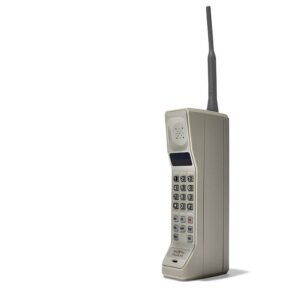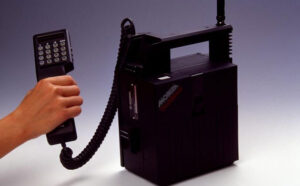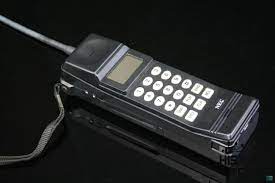In the previous post, we discussed 0G technology, which is the technology that powered mobile radio telephone systems. Mobile radio telephones had an issue of mobility. They were bulky and required a separate antenna to be attached before they could be used to make calls. .
Fortunately, cellular phones (1G phones) addressed this issue by having a size that is relatively small for individuals to be able to carry on the go.
Just like 0G phones, first generation mobile phones used analog wireless communication technology. The major difference between the two is that 1G phones were powered by more sophisticated network infrastructure that enhanced their coverage.
In this article, we will explore 1G technology and provide you with some of the key features it brought to first-generation mobile phones. We will first begin by explaining what 1G network is and then extend it to 1G phones.
What is 1G Network?
1G is a network generation that utilizes analog wireless communication technology to transmit signals (voice calls) from sender to receiver. It is the earliest generation of cellular phone networks and was first launched in Japan in the 1979s.
It used various network standards, including Advanced Mobile Phone Service (AMPS), Nordic Mobile Telephone (NMT), and Total Access Communication System (TACS). These networks transmitted voice calls using a frequency modulation (FM) signal on the 800 MHz frequency band.
1G networks relied on Frequency Division Multiple Access (FDMA), a multiple access system that divides the frequency band into multiple channels, with each channel assigned to a specific user for the duration of their call.
Unlike 0G networks, 1G networks had the ability to allow for direct dialing, which enabled users to call a phone number directly without the need for an operator.
1G networks also introduced the ability to make international calls, provided that the user’s carrier had a roaming agreement with a carrier in the destination country.
Additionally, 1G networks provide coverage over long distances with the help of cell towers, which were built in various locations across the country.
First Generation Mobile Phones (1G Phones)
First generation mobile phones are simply mobiles phones that use the 1G network technology.
Just at the same time that the 1G network was launched, the Nippon Telegraph and Telephone (NTT) company in Tokyo invented the 1G mobile phone. Within the next five years, it expanded to cover the whole of Japan.
Some years later (around 1981), Nordic Mobile Telephone (NMT) was launched in European countries. In 1983, Ameritech launched 1G mobiles in the USA using Motorola mobile phones.
Here is a videos of first generation mobile phones in use.
1G phones were based on different network standards, and several types of phones were developed to work with these standards. Here are some of the different 1G phones:
1) Motorola DynaTAC 8000X
This was one of the earliest commercially available 1G phones. It was introduced in 1983 and was based on the Advanced Mobile Phone Service (AMPS) network standard. The phone weighed 2.5 pounds and offered a talk time of around 30 minutes.

Image source: content.time.com
2) Nokia Mobira Senator
This was another early 1G phone, introduced in 1982. It was based on the Nordic Mobile Telephone (NMT) network standard and was popular in Scandinavian countries. The phone was large and heavy, weighing around 22 pounds.

source: english.newsnationtv.com
3) Ericsson Diavox
This was a 1G phone introduced in 1981 that was based on the NMT (Nordic Mobile Telephone) system. The phone was relatively compact and lightweight, weighing around 1.5 pounds.

Source: www.matilo.eu
4) NEC 9A
This was a 1G phone introduced in 1985 that was based on the Japanese NTT System network standard. The phone was relatively small and lightweight, weighing around 690 g.

Source:historictech.com
Limitation of 1G phones
- The voice calls were susceptible to interference and eavesdropping
- Call quality were affected by weather condition
- Limited number of users
- Limited distance coverage
- Poor battery life
- The phone size were large and not convenient to carry along
- Roaming was not possible between similar systems
Advantages of 1G phones over mobile radio telephone
- Direct Dialing: unlike mobile radio phones, 1G phones allowed users to call a phone number directly without the need for an operator to manually connect the call.
- Portability: 1G phones were much more portable than mobile radio telephones.
- Greater Coverage: 1G phones had a greater range than mobile radio telephones, allowing users to make calls from a wider range of locations.
- International Calling: 1G phones are allowed for international calls.
- Improved Call Quality: The analog technology used in 1G phones allowed for clearer, more reliable voice calls.
FAQ on First Generation mobile Phones
Here are some commonly asked questions concerning first generation mobile phones;
What is the first 1G mobile phone?
The 1G mobile phones is Motorola DynaTAC 8000X . It was introduce in 1983 in US. As the first handheld phone released in the US market, it played a pivotal role in the rise of mobile phones during the 1980s. The DynaTAC 8000X marked the beginning of the era of cellular networks and laid the foundation for the subsequent development and popularity of mobile phones.

How did 1G phones differ from landline phones?
1G phones were mobile and wireless, while landline phones, which were the primary means of communication before 1G, were wired and stationary.
Were 1G phones portable?
Yes, 1G phones were portable, allowing users to make calls while on the move. However, they were less portable than the modern mobile phone generation.
Which countries adopted 1G technology?
Various countries worldwide adopted 1G technology, including the United States, European nations, and others across the globe.
What was the battery life like for 1G phones?
Battery life for 1G phones was relatively short compared to modern smartphones, typically lasting a few hours of talk time.
Were 1G phones affordable for the general public?
Initially, 1G phones were expensive and considered a luxury item, limiting their affordability for the general public.
When and why did 1G networks transition to 2G networks?
The transition from 1G to 2G networks began in the late 1980s and early 1990s to address the limitations of 1G and introduce digital communication, improved call quality, and additional features.
Conclusion
With what we have covered, you have seen the improvement that the 1G network brought to wireless communication technology. It allowed people to use 1G for enhanced coverage, portability, improved call quality, direct dialing, and more.
Although 1G phones were relatively bulky and had limited capabilities compared to modern smartphones, they paved the way for the development of subsequent generations of mobile networks and devices, which continue to revolutionize the way we communicate and access information.

I am a passionate Networking Associate specializing in Telecommunications.
With a degree in Electronic engineering, I possess a strong understanding of electronic systems and the intricacies of telecommunications networks. I gained practical experience and valuable insights working for a prominent telecommunications company.
Additionally, I hold certifications in networking, which have solidified my expertise in network architecture, protocols, and optimization.
Through my writing skills, I aim to provide accurate and valuable knowledge in the networking field.
Connect with me on social media using the links below for more insights.
You can contact me using [email protected] or connect with me using any of the social media account linked below


